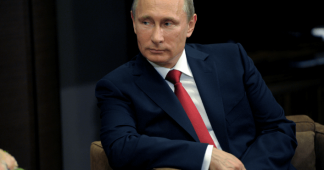Kabul has fallen, and it took the Taliban only a few weeks to sweep away the Afghan army, which had been financed and trained by the United States for twenty years. As a reminder, the communist regime had survived the withdrawal of the Red Army for three years. But the Afghan disaster, beyond a one-off defeat, is a sign of the fiasco of the “war on terror”.
By Alain Gresh *
Aug.17, 2021
It was the spring of 1988, and we were gathered in Kabul. In a declaration by Mikhail Gorbachev, general secretary of the Communist Party, the Soviet Union had just announced the unilateral withdrawal of its troops from Afghanistan by December 1979. For the first time, the regime had admitted a pool of 150 foreign journalists, most of them from the West and most of whose understanding of the history and culture of Afghanistan was dangerously close to zero. Their knowledge could be summed up in one rudimentary axiom: the war was between the mujahedin crowned with glory and the local Communist party, a mere puppet of the Soviet Union: the People’s Democratic Party which had seized power on 25 April 1978.
That evening, consigned to our hotel an hour before the curfew, we were invited to meet with the U.S.chargé d’affaires who gave us a detailed explanation, with the self-assurance of a general on the eve of a great victory, of how the rebels were going to take control of Kabul as soon as the last Soviet troops were gone. Armed with their certainties, fascinated by the “news” they had just heard, the journalists wandered through the streets of the capital in search of the image that would symbolise the inevitable defeat of the USSR, such as a tank that had fallen into the river running through the city, irrefutable proof of the collapse of the regime.
At the time, no one worried about the future of Afghan women. And yet, in the capital, only half of them wore the chadri, that veil which covers them from head to foot, leaving only a small wire-meshed opening for the face. You ran into this accoutrement in the corridors of official buildings and ministries but at that time women did have access to educational facilities, at least in the big cities.
Though our media saw the conflict as an East-West confrontation between Good and Evil, it did in fact involve other players than the two Great Powers. The Afghan Communist Party was composed of multiple tendencies, was very divided and had a limited but real influence among the “modernist” sectors of the population—notably the officers and soldiers—and among the ethnic minorities, which had led it to take power without the approval of the USSR which was on excellent terms with the overthrown president, Mohammad Daoud Khan. At the time, I had met some of the movement’s cadres and had seen how determined they were not to give up without a fight.
“Make the Russians bleed”
The Afghan resistance was split into many factions, and the radical tendencies (the term jihadists had not yet come into use) had grown stronger as the war went on and as the Red Amy multiplied its atrocities. But for the U.S. President Ronald Reagan and the West in general, they were all “freedom fighters,” taking on the “Evil Empire,” adorned with all the virtues of gallant knights and so moving in their traditional garb.
In a book published in 1995,1 U.S. journalist Selig S. Harrison and the UN mediator for Afghanistan and co-author, Diego Cordovez, one-time foreign minister of Ecuador, wrote: “Though Moscow was the bad guy, there were no good guys” in that affair. Yet for Washington, the war had to be “fought to the last Afghan” to “make the Russians bleed.” This strategy had been defined in 1980 by a young scholar who was soon to join the Reagan administration, Francis Fukuyama, whose book The End of History and the Last Man (1992) had not yet made him famous. In the name of its Manichean vision, the United States was going to torpedo UN efforts to guarantee a peaceful transition based on the withdrawal of the Red Army.
It is true that the U.S. strategists, and they were not alone, interpreted the Soviet intervention in Afghanistan as proof of an irresistible expansionism—the search for an access to the Southern seas, just another stage in world conquest. The French philosopher Jean-François Revel, far-sighted as always, proclaimed the end of democracies, incapable of resisting “the most dangerous of its enemies from without, communism, the current variant and most perfect model of totalitarianism…”
The making of jihadists
And yet the most “perfect model” had only a few years left to live, and the Red ATM tanks were not about to roll down the Champs Elysées2. The Afghan war, bankrolled by Washington, was not a major factor in the collapse of a system which was already dying, but it did give an un-hoped-for boost to the most extremist factions among the rebels whom the United States and Pakistan had been financing first: after all, they were the best fighters! It was as an extension of this long and bloody conflict that a generation of Afghan and Arab Jihadists were trained, a force that would then turn against the USA as 9/11 was to reveal. If Washington did not actually invent Al-Qaida as some would have us believe, its wrongheadedness was a contributing factor.3
But let us return to Kabul in the Spring of 1988. Contrary to the illusions of that U.S. diplomat, the regime survived for three years after the Red Army’s departure, resisted far better in fact than today’s Afghan authorities have done. It took the Russian decision to stop supplying weapons to its one-time ally and the defection of General Abdul Rachid Dostom,—an ethnic Uzbek, who has survived all the episodes of the war up to the present day—to bring down the regime. The ensuing years of civil war have strengthened the power of the Taliban, those “theological students” generously financed by Pakistan, that ally of the United States. They put an end to the warring between the different groups of Mujaheddins, took Kabul in 1996, established an obscurantist regime and provided a safe haven for Oussama bin Laden. But for Washington, the cold war was over and Afghanistan was no longer a priority. And the fate of Afghan women, sometimes used to justify the U.S. invasion, was quickly forgotten.4
“War against terrorism”, an endless downward spiral
But then, after 9/11, the USA embarked upon a new crusade, “the war against terrorism,” and invaded the country. But, like the Soviets, they found themselves bogged down in an endless conflict with no hope of victory. Their “surgical strikes” killed Taliban but also many innocent victims; the suicide attacks brought reprisals that did not spare the civilian population either; the “pacification” drove increasing numbers of Afghans to the big cities or into exile.
As for the U.S. promise to establish democracy, it was never kept. As Human Rights Watch put it as early as 2002, “when the United States drove out the Taliban in November 2001, the Afghans were promised a new democratic era with respect for human rights … the hopes that were raised never materialised.”5
Imposed from abroad, divided and corrupt, dependant on militia whose atrocities were widely documented,6 the country’s new rulers were soon seen to be minions of the USA, and a resistance movement developed which called down more repression. An unending vicious circle, similar to the nightmare experienced by the Red Army.
The end of empires and unwinnable wars
In 1969, well before the Soviet and U.S. interventions, an Afghan academic wrote a pamphlet introducing his country to foreigners: “One of the main traits of the Afghan character is their indomitable attachment to their independence. Afghans can put up patiently with ill luck or poverty but cannot be made to resign themselves to domination by a foreign power, however, enlightened or progressive.” Three times in the course of recent history, in 1842, 1881 and 1919 the British empire encountered disastrous confirmation of this principle. The first two times, what was at stake was “forestalling” Czarist incursions into Asia which appeared to threaten India, the jewel of the imperial crown: the third time was to cope with the development of a nationalist anti-colonial movement in the country. The USSR came next, trying to “forestall” “imperialist plotting” and today it is the turn of the United States to withdraw at the end of the longest war in its history, waged in the name of the necessity to eradicate terrorism.
In the nineteenth and early twentieth centuries, those imperial setbacks were something of an exception at a time when colonial empires still held sway over the planet. Whereas the defeats that came after were mostly confirmations that the very idea of empire was dead, and that independence was henceforth to be the order of the day for those peoples once thought of as “under age.”
In a recent assessment drawn up by the prestigious Center for Strategic & International Studies in Washington, D.C., one of its main analysts, Antony Cordesman, had this to say: “If one examines the cost of the war and the lack of any clear or consistent strategic rationale for continuing it, then it is far from clear that the U.S. should ever have committed the resources to the conflict that it did or that it had the grand strategic priority to justify two decades of conflict.”7
And yet in fact the intervention in Afghanistan had been decked out with a “strategic priority”: “the war on terrorism,” and it had been joined by a number of other governments (including even France after its initial reticence). This “twenty years’ war”8 enrols under its banner every conflict, every insurrection, every protest anywhere on the planet in an eschatological struggle against evil, against an elusive and indestructible chimera called terrorism. Now the latter is not “an enemy” but a form of action which has come down through history and been employed by movements as diverse as anarchism, Zionism, Irish nationalism, or Al-Qaida, but also—and this is much less talked about—national governments (France in Algeria or Israel in the Middle East).
Thus, the U.S. defeat in Afghanistan marks above all the fiasco of one such unwinnable war and their different variants from the Sahel to Kurdistan, from Palestine to Yemen and which only add fuel to the phenomenon they claim to combat. How much longer will it take to draw the necessary consequences?
* Alain Gresh, is Publication director of Orient XXI. A specialist in the Near East, he is the author of several books, including De quoi la Palestine est-elle le nom ?, Les Liens qui libèrent, 2010 and et Un chant d’amour. Israël-Palestine, une histoire française, with Hélène Aldeguer, éditions La Découverte, 2017.
We remind our readers that publication of articles on our site does not mean that we agree with what is written. Our policy is to publish anything which we consider of interest, so as to assist our readers in forming their opinions. Sometimes we even publish articles with which we totally disagree, since we believe it is important for our readers to be informed on as wide a spectrum of views as possible. In the particular case of Afghanistan, it is very difficult to verify the information coming from or regarding this country. We are also certain that much of it is being used for various information/propaganda wars.
Published at orientxxi.info










